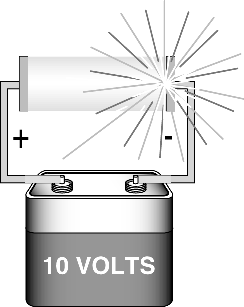Inquiring Minds
|
Physics at Fermilab main page | accelerators | collider experiments | neutrino physics | technology computing | theory | astrophysics | discoveries at Fermilab |
|
|
|
|
How to Accelerate a Proton To explore the smallest of the small, the particles inside the atom, physicists use the largest of scientific instruments, particle accelerators with outer dimensions measured in miles. These giant tools of particle physics can accelerate subatomic particles to very close to the speed of light. To discover the top quark, Fermilab physicists used the world's most powerful accelerator, the Tevatron, to accelerate beams of protons and antiprotons. The protons and antiprotons travel in opposite directions around the Tevatron's four-mile circumference. When proton and antiproton meet, they collide with enough energy to produce the elusive top quark once in every few billion collisions. How does the Tevatron accelerator work?
Opposites attract All particle accelerators start from the principle that electrically charged objects exert a force on each other--opposite charges attract; like charges repel. That is, a particle with a positive or negative charge experiences a force when it is in the presence of an electric field. When a net force acts on an object, the object accelerates. A proton accelerator keeps applying the force to accelerate protons until they are going at almost the speed of light. To make the simplest kind of accelerator, we could use two parallel metal plates separated by a gap and connected to each other by a battery. We connect one plate to the positive battery terminal and the other to the negative terminal. The battery creates an electric field in the gap between the two plates. A positively charged proton-- a hydrogen atom stripped of its single electron--that enters the gap near the positive plate experiences a force and accelerates across the gap toward the negative plate, gaining an amount of energy equal to the voltage of the battery times the electric charge of the proton. For a 10-volt battery, the proton gains 10 electron volts, or 10 eV, as it accelerates between the plates. Accelerators similar to this simple device, but using more sophisticated voltage sources than batteries, can give protons up to a few tens of millions of electron volts. Raising the energy To give the proton still higher energy, we can send it through a series of small acceleration gaps, one after another. A proton moving along its path approaches the first acceleration gap in the path. The gap is like the one between the plates connected to the battery, but with a much higher voltage. Once the proton enters the gap, it feels the force of the electric field and accelerates to the negative side of the gap, gaining energy. It speeds on its way down the path with its added energy. We now send the proton through a second gap. It gains a second boost of energy on top of the first. By sending the proton through many accelerating gaps, and shielding it from the electric field when it is between gaps, we can use a succession of small voltages to boost the proton to a higher and higher energy. Accelerators that work this way are called linear accelerators, or linacs, and they can accelerate protons to a few hundred million electron volts or MeV. The more gaps a linac has, the higher the energy it can give to a proton--and the longer the linac gets. When a linac runs out of real estate, it reaches its energy limit. Now, what if we take the proton as it shoots out the end of the linac and bend its path around to the beginning, to go through the series of acceleration gaps again, but this time at a much higher starting energy? We can send it back to the beginning many times, each time at a higher energy than before. In fact, we do exactly this. Because the path of a moving charged particle bends in a magnetic field, we can use magnets to bend the proton's path, sending it circling back to the beginning. Each time the proton goes around the circle and through the accelerating gaps it gains more energy. To keep it on the same circular path as it gains energy, we must make the magnetic field slightly stronger each time it goes around. We synchronize the increase in the magnetic field with the proton's increasing energy. To keep our proton and billions of others like it circling together, we focus them into a tight beam. Voila! We have made a circular accelerator of the type called a synchrotron, of which Fermilab's Tevatron is the world's most powerful. Our proton synchrotron gives particles energies of nearly a trillion electron volts, or one TeV. Add 10 billion antiprotons While the protons are speeding around the accelerator ring, we feed a batch of antiprotons into the same ring. Antiprotons are particles just like protons, but with a negative charge. Their opposite charge makes them accelerate like the protons, through the same gaps but in the opposite direction. Their opposite charge also allows them to be bent in the same circle by the magnets, but traveling the opposite way around. We have now produced two intense beams of particles orbiting the accelerator ring in opposite directions at close to the speed of light. When we decide to bring the beams together at a point in the accelerator ring, we will cause millions of high-energy collisions yielding hundreds of different kinds of particles, one of them, perhaps, a top quark.
|
| last modified 02/26/2001 email Fermilab |
FRLsDFx9eyfrPXgV



